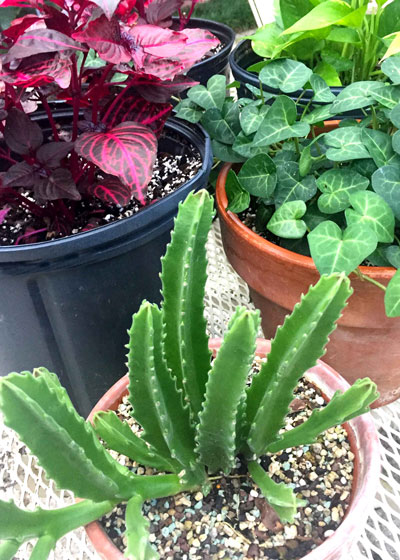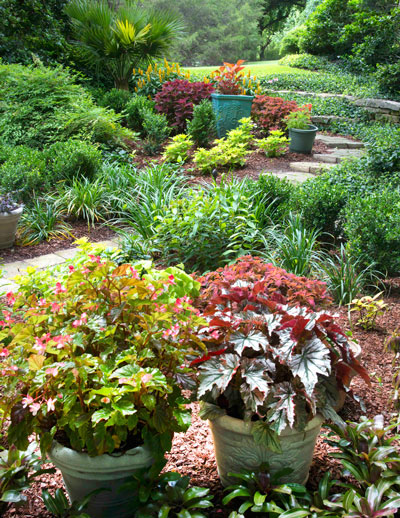From the Sperry Garden: Potting Soils
I’m frequently asked to recommend a brand of potting soil. I say that I haven’t found one that I really like, so I mix up my own.

Photo: Stapelia (foreground) requires perfectly draining soil mix. Sweetheart English ivy and bloodleaf do better in soils that retain more moisture.
The complaint I have with the commercial potting soils I’ve tried is that they’re all way too “heavy.” I’m not really referring to their actual physical weight, but more to their water-holding capacity and density. I tell people that when they pick up a bag of the perfect potting soil, they ought to exclaim, “Wow. I expected it to be a lot heavier.”
I grew up in College Station at a time when floriculture professor A.F. deWerth was experimenting with sphagnum peat moss and a relatively new product called perlite. Most of the plants in his greenhouses (which I helped tend) were being grown in 50-50 mixes by volume. The peat was dry when we mixed it, and perlite always is, too, so those wheelbarrows didn’t weigh much more full than when they were empty.

Photo: The Sperry gardens always feature dozens of plants in containers. They’re easier to maintain, and I can adjust their potting soils to be perfect matches for their needs.
So that was where I cut my teeth, and I haven’t strayed very far ever since. Here is the rough recipe I follow when I’m mixing up potting soil even today. (All of these percentages are according to volume, not weight.)
• 50 percent highest quality sphagnum peat moss;
• 20 percent finely ground pine bark mulch;
• 20 percent horticultural grade perlite; and
• 10 percent expanded shale.
Expanded shale is a clay material that, like perlite, expands when it is heated to approximately 2,000 degrees. I include it with my potting soil mix because it adds weight, or ballast to the containers. It makes them less likely to blow over in windstorms.
I also use expanded shale to improve drainage with my cactus and succulent collection – plants like the stapelia you saw in the lead photo to this story on the prior page. In those cases the final mix may be as much as 30 or 40 percent expanded shale. I figure I can always add water, but it’s much more difficult to subtract it. Expanded shale stays in place in the potting soil. I used to use perlite before shale came along, but it floats to the tops of the pots.
Fine tunings and feedings…
One other place where I will adjust my potting soil mix: hanging baskets. There’s no point in bending a tree limb or pulling the eaves off the house by having expanded shale in hanging baskets’ potting soil. In those cases I go back to the days of old. All the expanded shale gets changed over to perlite, so I have 50 percent sphagnum peat moss, 20 percent finely ground pine bark mulch and 30 percent horticultural perlite.
Just for the record, yes, clay pots do dry out more rapidly than plastic pots. However, I don’t change my potting soils dependent on the type of pot. I change my watering habits instead.
Finally, these potting soils are inherently sterile. They have no built-in nutrition, so you’re going to have to feed your plants every few times that you water them. I use a high-nitrogen, water-soluble plant food, and I couple it with a timed-release, high-nitrogen product for sustained feeding.
